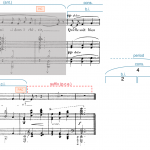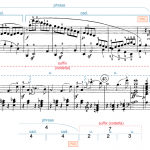III. Form
Expansion and Contraction at the Phrase Level
John Peterson
Key Takeaways
- Expansions make a phrase last longer than expected. They can be internal (between the beginning and ending of the phrase) or external (before the beginning or after the end).
- Internal expansion techniques include repetition, stretching, one-more-time technique, and alternative path.
- External expansions fall into two categories:
- Prefixes occur before the beginning, such as an introduction.
- Suffixes occur after the cadence, such as post-cadential extensions, codettas, and codas.
- Contractions make a phrase shorter than expected.
The terms expansion and contraction refer to ways composers play with the expected length of a phrase.
What does “expected length” mean?
- When a phrase invokes one of the archetypes without following it exactly, we can often identify how long a closer representation of that archetype would have been.
- Sometimes the cadential motion of the phrase allows us to anticipate where a cadence might occur, but the phrase evades the expected cadence.
- Sometimes a piece states two versions of a phrase—one unexpanded and the other expanded—giving us a model to which we can compare the expanded version.
Expansion refers to the process of making a phrase longer than we expect. This lengthening might occur within the phrase (“internal expansion“) or outside of the phrase (“external expansion“). Contraction refers to the process of making a phrase shorter than we expect, and it always occurs within a phrase.
In this chapter, we offer an overview of several techniques for phrase expansion and contraction. This isn’t an exhaustive list, but it covers several of the more common techniques. The terminology concerning expansion and contraction techniques can quickly become overwhelming. What’s most important is to be able to recognize when a phrase is longer or shorter than expected and to be able to describe what’s creating the difference in length.
Internal Expansions
The four techniques we discuss below—repetition, stretching, one-more-time, and alternative path—all occur within a phrase: after the phrase’s beginning, but before its cadence. Often, composers use these techniques in combination; in fact, it’s relatively rare to find a phrase that’s expanded using only one technique.
Repetition
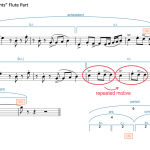
Sometimes when a composer repeats material, the repetition creates extra length.
Example 1 shows an exact repetition of a motive within a unit that creates extra length: a four-measure antecedent is followed by an expanded five-measure consequent. The extra length results from a repeated motive within a unit.
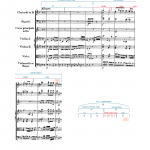
Example 2 shows a varied repetition in which a whole unit is repeated to add extra length: a four-measure compound basic idea (c.b.i.) is followed by a five-measure continuation. The continuation begins with a sequence that expands it from the expected four measures to five.
Not all repetitions create expansion! Be careful to differentiate expansion-creating repetitions, which are unexpected, from more predictable repetitions, such as when the basic idea is repeated in a presentation.
Stretching
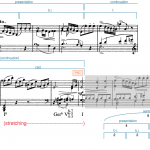
Sometimes composers will lengthen a harmony or melody by increasing its duration so that it lasts longer than expected. When that happens, we say that the unit that contains the harmony or melody has been stretched. In Example 3, a four-measure presentation is followed by a five-measure continuation. The continuation’s cadential idea is stretched when a [latex]\mathrm{I}^6[/latex] chord and the cadential dominant (embellished by a [latex]\mathrm{Ger}^6[/latex] and a cadential [latex]^6_4[/latex]) each last for a full measure as opposed to both occurring within a single measure.
One-More-Time Technique (o.m.t.)
Coined by Janet Schmalfeldt (1989), the one-more-time technique involves three steps: 1) the music tries to cadence, 2) the attempted cadence is evaded, and 3) the music retries the cadence. The re-tried cadence often uses the same material, such that it feels like the music is “backing up,” but it may also retry the cadence with different cadential material.
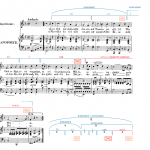
In Example 4, a cadence is proposed in m. 10, but it’s evaded ([latex]\mathrm{cad^6_4 – V^4_2 – I^6}[/latex]). A one-more-time repetition of the cadential idea ensues. The one-more-time unit is stretched: notice that it takes two measures (compared to one originally) for the melody to descend C–B♭–A–G, and it takes a full measure (compared to a half measure originally) for the cadential [latex]\mathrm{^6_4}[/latex] to resolve to [latex]\mathrm{V}^7[/latex].
Alternative Paths
An alternative path occurs when unexpected new material either temporarily or permanently causes a phrase to deviate from its expected trajectory toward a cadence. A temporary deviation is called a detour. Detours return to previous material from within the phrase before the phrase achieves a cadence. A permanent deviation is called a reroute. Reroutes achieve cadences without returning to previous material from within the phrase.
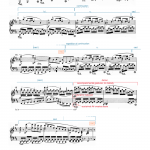
Example 5 shows a detour: the sentence’s continuation is repeated. We realize the repetition is getting “off track” when the motive in the cadential idea (m. 19) is repeated (m. 20), which did not happen in the analogous place before (m. 15). A highly contrasting two-measure passage emerges (mm. 21–22) that leads to a return of material (mm. 23–26) similar to the cadential idea in mm. 19–20, now stretched.
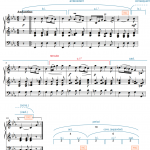
Example 6 shows a reroute: a four-measure antecedent is followed by a six-measure expanded consequent. The consequent begins with the same basic idea as the antecedent, but its contrasting idea moves in a markedly different direction, one that doesn’t lead to a cadence. A new cadential idea is needed to bring the phrase to a perfect authentic cadence (PAC).
Although one-more-time technique and alternative paths both involve cadences, they are very different techniques, as explained below:
| One-more-time technique | Alternative path |
|
|
External Expansions
When composers add length outside of a phrase, they may add measures before the beginning (prefixes) or after the cadence (suffixes). In diagrams, we indicate external expansions using dashed arcs or brackets.
The Prefix
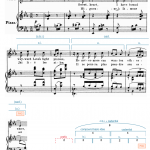
A prefix occurs before the beginning of a phrase, usually taking the form of an introduction. A prefix can be small, but it may also be large, such as when a composer begins a symphony with a slow introduction. Example 7 shows a small prefix. As is very common with songs, this mélodie opens with an instrumental introduction before the singer enters—that is, before the phrase beginningg. Note also that this phrase includes a variant on the typical core bass cadential pattern. Instead of mi-fa-sol-do ([latex]\hat{3}-\hat{4}-\hat{5}-\hat{1}[/latex]), Chaminade writes di-re-sol-do ([latex]\uparrow\hat{1}-\hat{2}-\hat{5}-\hat{1}[/latex]) (mm. 8–11).
The Suffix
A suffix occurs after a phrase has cadenced. The terms in Example 8 are flexibly used to describe different types of suffix. While Example 8 provides guidelines for their use, what one person calls a post-cadential extension, another might choose to call a codetta. It’s more important to recognize that a given suffix adds length outside the bounds of a phrase than to worry about which term is most appropriate.
| Term | Avg. Length | Characteristics | Typical Location | Example |
|---|---|---|---|---|
| Post-cadential extension (p.c.e.) | Short (1-2 mm.) |
|
After the end of a phrase within a section | Example 9 |
| Codetta | Medium (4-8 mm.) |
|
After the end of a section within a piece or movement | Example 10 |
| Coda | Long (8+ mm.) |
|
After the end of a piece or movement | Example 11 |
Example 8. Characteristics that differentiate common suffix types.
Example 9 shows the end of a lengthy period. After the perfect authentic cadence that ends the consequent, a two-measure post-cadential extension prolongs the final tonic via arpeggiation.[1]
In Example 10, a lengthy phrase ends the exposition of the piano sonata with a PAC in A♭ major at m. 41. The cadence is followed by a codetta: notice that it features a repeated two-measure unit harmonized with the cadential bass line fi-sol-do ([latex]\uparrow\hat{4}-\hat{5}-\hat{1}[/latex]).
Example 11 features the longest kind of suffix: a coda. After the introduction returns (4:52) and then is varied (5:03), an elided PAC ends the piece proper (5:32). The coda (also at 5:32) presents an energetic celebration of the piece’s closure, featuring a fast version of a previously-heard theme with several phrases.
- Example 9. External expansion via suffix (post-cadential extension) in Cécile Chaminade, “Les presents” (2:31–2:57).
- Example 10. External expansion via suffix (codetta) in Beethoven, Piano Sonata Op. 2, no. 1, mm. 36–48 (0:45–0:58).
| Timestamp | Event |
|---|---|
| 4:52 | Introduction returns in varied form |
| 5:03 | A second variation on the introduction begins |
| 5:32 | Coda begins; its material is drawn from the second theme (from 2:00) |
Example 11. External expansion via suffix (coda) in Shostakovich, Festive Overture.
Contraction
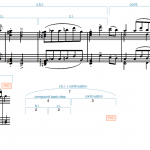
Contractions occur less frequently than expansions. A contraction occurs when a phrase is shorter than we might expect it to be.
In Example 12, a four-measure compound basic idea is followed by a three-measure continuation. Given the length of the compound basic idea, we might have expected the continuation to be four measures long to create proportional balance. As you listen, notice how the cadence feels abrupt, a feeling that usually accompanies contraction.
- Jarvis, Brian, and John Peterson. 2019. “Alternative Paths, Phrase Expansion, and the Music of Felix Mendelssohn.” Music Theory Spectrum 41, no. 2 (Fall): 187–217.
- Schmalfeldt, Janet. 1992. “Cadential Processes: The Evaded Cadence and the ‘One More Time’ Technique.” Journal of Musicological Research 12 (1–2): 1–52.
- Analyzing expansion techniques (.pdf, .docx). Asks students to name, segment, and label the form of excerpts and identify the location of any expansion technique(s). Optional harmonic analysis included. Worksheet playlist
- Analyzing multiple expansion techniques (.pdf, .docx). More complicated examples than in worksheet 1. Each excerpt is significantly expanded. Worksheet playlist
- Recomposing to remove expansions (.pdf, .docx). Asks students to recompose excerpts from worksheet 1 to remove the expanded portion of the archetypal form. Worksheet playlist
Media Attributions
- Example_001_Repetition_Sheldon_Bright_Lights © John Peterson and Megan Lavengood is licensed under a CC BY-SA (Attribution ShareAlike) license
- combined-Example_002b_Repetition_Mozart_447-3 © John Peterson and Megan Lavengood is licensed under a CC BY-SA (Attribution ShareAlike) license
- Example_003a_Stretching_Schubert_459 © EXAMPLE 2. Internal expansion via varied repetition in Mozart's Horn Concerto, K. 447, I, mm. 1–9 (0:00–0:18). is licensed under a CC BY-SA (Attribution ShareAlike) license
- Slide5-6 © John Peterson and Megan Lavengood
- Slide8-10 © John Peterson and Megan Lavengood
- Slide10-11 © John Peterson and Megan Lavengood
- Slide12-13 © John Peterson and Megan Lavengood is licensed under a CC BY-SA (Attribution ShareAlike) license
- Example_013_Contraction_Elmas_PC_1_III © John Peterson and Megan Lavengood is licensed under a CC BY-SA (Attribution ShareAlike) license
- The recording linked is the only commercial recording of the piece. We hope more people will record this beautiful work. ↵
The process of making a phrase longer than expected. This lengthening might occur within the phrase (internal expansion) or outside of the phrase (external expansion).
A technique of internal phrase expansion. Sometimes a composer repeats material to create extra length in a phrase. Such repetitions may be exact or varied.
A technique of internal phrase expansion. It occurs when a composer lengthens a harmony or melody by increasing its duration so that it lasts longer than expected. When that happens, we say that the unit that contains the harmony or melody has been stretched.
A technique of internal phrase expansion. Coined by Janet Schmalfeldt, the technique involves three steps: (1) the music tries to cadence, (2) the attempted cadence is evaded, and (3) the music retries the cadence.
A technique of internal phrase expansion. It occurs when new material causes a phrase to deviate from its expected trajectory toward the cadence. These deviations may be permanent ("reroutes") or temporary ("detours").
An external expansion that occurs before the beginning of a phrase. Prefixes are usually introductions, and they may be small, as when the accompaniment for a lied begins before the singer, or they may be large, as when a symphony begins with a slow introduction.
A type of external expansion that occurs after the end of a phrase. There are three terms commonly used to describe suffixes, ranging in size from smaller to larger: post-cadential extension, codetta, and coda.
A type of suffix (external expansion). Post-cadential extensions are usually short, they often occur at the ends of phrases within a section, and they typically prolong the final chord of the cadence or re-state the two chords that created the cadence.
A type of suffix (external expansion). Codettas are usually medium length (for example, between 4 and 8 measures), they often occur at the end of a section within a piece, and they often feature repeated units. They may or may not contain a full phrase.
A large suffix section occurring at the end of a work (or end of a movement within a multi-movement work), after the PAC that ends the piece’s core sections.
Contraction refers to the process of making a phrase shorter than expected. It always occurs within a phrase.
A relatively complete musical thought that exhibits trajectory toward a goal (often a cadence).
Phrases that are "archetypal" or that follow an archetype are related to the sentence, the period, or one of the hybrid phrase-level forms.
Any situation where a composer sets up the expectation for a cadence, then avoids cadencing. Examples include deceptive motion, inversion of the cadential dominant or tonic, and/or omitting an essential voice (such as the bass note of the tonic chord or the soprano note of the tonic chord).
Making a phrase last longer than we expect by lengthening it after it begins, but before it cadences.
Lengthening a phrase by adding extra material to it either before it begins ("prefix") or after it cadences ("suffix").
A phrase consisting of a basic idea followed by a contrasting idea that ends with a weak cadence.
A phrase consisting of a basic idea followed by a contrasting idea that ends with a strong cadence. It usually forms the second half of a phrase-level form.
A regularly recurring unit of music that's smaller than an idea, and which is typically transformed across a work. The word "motive" usually refers to pitch material, but other kinds of motives such as rhythmic or contour also exist.
A compound basic idea (c.b.i.) is an antecedent without a cadence. It consists of a basic idea followed by a contrasting idea.
A subphrase that features a mix of any of the following: fragmentation, increase in harmonic rhythm, increase in surface rhythm, or sequences. Continuations end with a cadence and are usually found in the second half of a theme.
A pattern that is repeated and transposed by some consistent interval. A sequence may occur in the melody, the harmony, or both.
A subphrase consisting of a basic idea and its repetition. Presentations don't usually end with cadences.
One of the three common ending types. Its distinguishing characteristic is its bass line: mi–fa–sol–do (3̂–4̂–5̂–1̂), which may be elaborated with chromaticism.
A type of alternative path. A detour creates a temporary deviation from a phrase's expected trajectory toward a cadence. Detours are initiated by a diversion onto the detour and they end with a resumption of rhetoric from earlier in the phrase.
A type of alternative path that involves a permanent change of a phrase's trajectory toward the cadence. Reroutes are initiated by a diversion.
Basic ideas are short units that are typically associated with beginnings. They don't usually end with cadences, and they often establish tonic. They are the first units we hear in a presentation, an antecedent, a consequent, and a compound basic idea.
A small unit that contrasts with the material that came immediately before it, usually in terms of contour. It's featured in the antecedent and the compound basic idea.
A V–I cadence that ends with do (1̂) in the melody. Both harmonies must be in root position.
A French-language art song.
A core bass pattern is the basic series of notes that defines a common progression. This series of notes may be embellished with other, less important notes, but the pattern is still recognizable because the basic series is still present.
A phrase-level form that consists of two phrases: an antecedent and a consequent.
A coda is a song-ending section that presents new material. Like outros, codas exhibit closing rhetoric.

